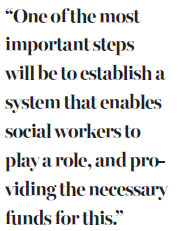Getting to the heart of 'left-behind' children
Updated: 2016-04-22 07:10
By Guan Xinping(China Daily Europe)
|
|||||||||
The ministries of civil affairs, education and public security are to survey the general situation of "left-behind" children in China's rural areas. Since the start of reform and opening-up in the late 1970s, many rural residents have left home to work in cities, leaving their children in the care of grandparents or to fend for themselves.
Children who are separated from their parents in their formative years face many problems in terms of education, security and mental health. Some left-behind children have committed suicide or have been sexually abused.
The problem should be seen as part of the greater issue of migrant workers in China.
Realizing the gravity of the problem, central and local authorities have taken measures to safeguard migrant workers' basic rights and to provide protection for left-behind children.
For example, the Communist Party of China has announced measures to improve care services for the children, women and senior citizens in rural areas. And the 13th Five-Year Plan (2016-20) includes protection of left-behind children as a basic public service item. In February, the State Council also issued a guideline for improving care services for left-behind children.
However, the national survey by the three ministries is the first substantive step to comprehensively carry out the care and protection work for left-behind children.

Providing proper care and protection is a large-scale and long-term endeavor that requires a huge amount of resources. To effectively implement such a project, the authorities should make scientific planning and arrangements, and get a clear idea about the actual situations these children live in.
The population of left-behind children is huge. They are scattered nationwide. True, some research organizations have done sample surveys, but they have only drawn deductive conclusions without offering a clear picture of the specific situations in which left-behind children live.
In this regard, the ministries' survey will not only present a clear picture of the real situation in different regions, but also will reveal specific individual conditions. The survey could thus offer the basis for making decisions both at national and local levels.
Although it is not difficult to conduct a national survey on left-behind children, local authorities can ensure the results are accurate by helping the process with efficient work. After completing the survey, central and local authorities should analyze the actual difficulties and needs of left-behind children and devise specific action plans, including targeted services for key groups and key areas, setting up mechanisms and regulations, investing resources and evaluating the processes based on actual situations.
One of the most important steps will be to establish a system that enables social workers to play a role, and providing the necessary funds for this.
Moreover, care and protection services for left-behind children should be combined with rural social welfare, and rural social and economic development.
Also, solving the problem should be linked to the protection of migrant workers' rights and interests in urban areas. Only when city authorities allow migrant workers to become permanent residents, to enjoy all social welfare services, will left-behind children's problems be truly solved.
The author is a professor at Nankai University's Institute of Social Development and Administration in Tianjin.The views do not neccessarily reflect those of China Daily.
Today's Top News
Inspectors to cover all of military
Britons embrace 'Super Thursday' elections
Campaign spreads Chinese cooking in the UK
Trump to aim all guns at Hillary Clinton
Labour set to take London after bitter campaign
Labour candidate favourite for London mayor
Fossil footprints bring dinosaurs to life
Buffett optimistic on China's economic transition
Hot Topics
Lunar probe , China growth forecasts, Emission rules get tougher, China seen through 'colored lens', International board,
Editor's Picks

|

|

|

|

|

|







